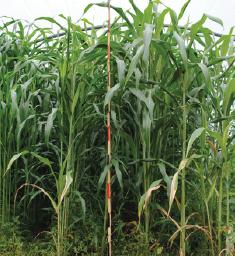In recent years, the use of sorghum (Sorghum bicolor) in crop rotation as a green manure to decrease nematode infestation and promote the growth of subsequent crops has strongly increased. The reason why sorghum is effective in biofumigation against root-knot nematodes is because it releases dhurrin, a cyanogenic glycoside found in epidermal leaf tissue. Currently, there is little information regarding dhurrin production deriving from dhurrin concentration and biomass produced. A field study was conducted in northeastern Italy to investigate the change in dhurrin content and biomass production of three commercial sorghum-sudangrass cultivars (Hay Day, Mataco, and Ruzrok), over their entire growth cycle under seeding dates (May and July). Regardless of the growing period, Ruzrok displayed a higher dhurrin production. During the early growth stages, Ruzrok did not exhibit a higher yield compared with Mataco and Hay Day, hence its higher potential as a biofumigant is due to the higher concentration of dhurrin in plant tissues. During spring conditions, all tested cultivars showed higher dhurrin production up to a height of 100 cm, while the amount of dhurrin did not significantly change during the entire growing period in summer.
Reference: Macolino, S., Pornaro, C., Pignata, G., & Lauriault, L. (2024). Dhurrin content and biomass yield in sorghum hybrids throughout plant growth cycle. Agrosystems, Geosciences & Environment, 7, e20472. https://doi.org/10.1002/agg2.20472
Error




